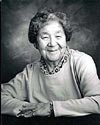
 |
||
| Home Page | Wetaskiwin Businesses | Community Organizations | Municipal Index | Maps | Site Map | Contact Us | | Photo Ads| | Camrose Online | Ponoka Online | ||
| History of Wetaskiwin: All information within has been provided by the Wetaskiwin & District Heritage Museum. |
| Search For Other Stories: Back to Women of Aspenland List |
 Topic: The Women of Aspenland
Topic: The Women of AspenlandArticle: Theresa (Minde) Wildcat Date Posted: November 9/2005 Main District: Hobbema (Ermineskin Band) Decades: 1920's to 2000's Theresa, the eldest of three girls, was born on the Ermineskin Reserve on December 9, 1927 to Joe and Emma Minde. She was initially educated at the Ermineskin Residential School and then encouraged by her family to continue her studies at St. Joseph's Convent in Red Deer. Because English was not her first language and her initial education at Hobbema was predominately home economics, Theresa had to persevere until she reached the academic standing which would allow her to graduate from grade 12. Theresa then attended the University of Alberta and got her teaching certificate in 1953. Her path led to Southern Alberta where she taught at the Kainia First Nation School in Cardston and then at the Siksika First Nation School in Gleichen. After spending years away from home she came back to Hobbema and taught at the Ermineskin Cree Nation School. Her return led to courtship and the eventual marriage to Sam Wildcat in 1957. Their oldest child was born the next year and for the next several years, Theresa devoted her time and energy to raising their family of five children, Brian, Carol, Darrel, Clara and Daniel. During this busy time, she was not a stranger to the school in Ermineskin and substituted if needed. However, her talent and belief that you can do anything you set out to, soon led to many varied opportunities for Theresa. Much to her surprise she was nominated by her brother-in-laws and then elected as the first woman Councilor of the Ermineskin Band in 1965. She chaired the Four Band School Committee monthly meetings (consisting of the Louis Bull, Samson Ermineskin, and Montana bands) which presented a challenge and opportunity to learn this role. About the time her term was up, she became a member of the Ermineskin School committee of which she remained for ten years. In the late 1960's, Theresa helped establish and edit the Bear Hills Native Voice newspaper, which existed for the next two decades. In the 1970's, Theresa continued to serve both at the community level and beyond. She was asked to sit on a Provincial Manpower Committee. Theresa was asked by the University of Calgary for her advice and recommendations in establishing a Native Student Center. This became a focal point for many native students attending the university. At the end of the decade, Theresa sat on the Senate at the University of Alberta for many years. She was a founding member of the Alberta Native Teacher's Society, the first of its kind in Alberta. No doubt the most important and far-reaching event of the decade for Theresa was her involvement in the founding of Maskwachees Cultural College in Hobbema in 1976. For Theresa, the college was more than an institution. It signified a beginning, where culture would be high priority and language could follow, because as Theresa believes, if the Cree language is lost, then the identity and all that goes with it is lost. To this end, one of the first activities begun by the college was the "Living History Project". Theresa's role was to interview all the elders over a period of several years. From the elders she collected their stories and family histories. The knowledge and background gained from the interviews led to another significant project, the Creeway Program. Creeway was a program that was used both in Hobbema and outside of the community to promote language, identity and culture to native and non-native peoples alike. When Theresa was invited by a local teacher to come to his classroom and discuss the community, she was able to use what she had learned from the interviews with elders. Since that beginning it has expanded, been adapted for various audiences and is still in use today. The program has also been used in Red Deer and Camrose. Finally, in 1978 Theresa co-founded the Ermineskin Education Trust Fund, which encourages achievement in academics and sports. In 1981, Theresa assisted with the development and writing of the Ermineskin constitution. It was the first constitution created by a First Nation Band. Now she is involved in educating the Hobbema community in the awareness of diabetes and is a member of the Hobbema Indian Health board. She co-authored a segment for a handbook used by Alberta women's shelters on native protocol and respect of the Cree culture and tradition. Theresa is presently sitting with a committee of students at the University of Alberta who are working to protect and promote the Cree language and culture. She is still involved in the Creeway Program, which she teaches at the Ermineskin Alternate School. Theresa is a loving mother, kokum, great-kokum, historian, educator and community volunteer. As a mother and grandmother she has instilled a strong work ethic and high moral and academic expectations in her children. As an historian she believes that you need to understand your past and your roots because that is who you are and what you do. Education is imperative because it is the way to improve your life and to advance the community. She has spent her lifetime living this philosophy.
|
| Feedback: On behalf of Wetaskiwin Online I am pleased to offer these historical articles from the Wetaskiwin and District Museum for all our online viewers.
Should you have feedback regarding any of these articles please contact the Museum using the information further below.
Sincerely: Wetaskiwin & District Heritage Museum 5007 - 50 Avenue Wetaskiwin, Alberta T9A 0S3 Email: |